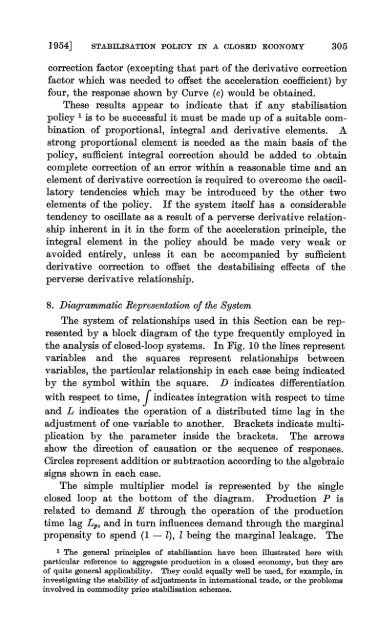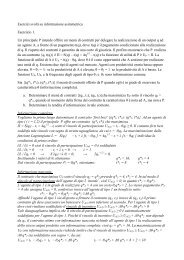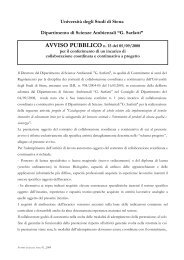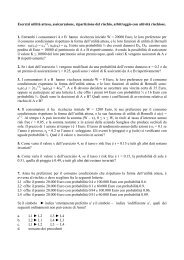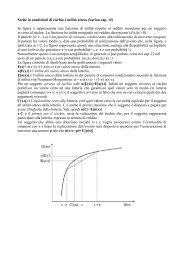Stabilisation Policy in a Closed Economy Author(s): A. W. Phillips ...
Stabilisation Policy in a Closed Economy Author(s): A. W. Phillips ...
Stabilisation Policy in a Closed Economy Author(s): A. W. Phillips ...
Create successful ePaper yourself
Turn your PDF publications into a flip-book with our unique Google optimized e-Paper software.
1954] STABLISATION POLICY IN A CLOSED ECONOMY 305<br />
correction factor (except<strong>in</strong>g that part of the derivative correction<br />
factor which was needed to offset the acceleration coefficient) by<br />
four, the response shown by Curve (e) would be obta<strong>in</strong>ed.<br />
These results appear to <strong>in</strong>dicate that if any stabilisation<br />
policy 1 is to be successful it must be made up of a suitable com-<br />
b<strong>in</strong>ation of proportional, <strong>in</strong>tegral and derivative elements. A<br />
strong proportional element is needed as the ma<strong>in</strong> basis of the<br />
policy, sufficient <strong>in</strong>tegral correction should be added to obta<strong>in</strong><br />
complete correction of an error with<strong>in</strong> a reasonable time and an<br />
element of derivative correction is required to overcome the oscil-<br />
latory tendencies which may be <strong>in</strong>troduced by the other two<br />
elements of the policy. If the system itself has a considerable<br />
tendency to oscillate as a result of a perverse derivative relation-<br />
ship <strong>in</strong>herent <strong>in</strong> it <strong>in</strong> the form of the acceleration pr<strong>in</strong>ciple, the<br />
<strong>in</strong>tegral element <strong>in</strong> the policy should be made very weak or<br />
avoided entirely, unless it can be accompanied by sufficient<br />
derivative correction to offset the destabilis<strong>in</strong>g effects of the<br />
perverse derivative relationship.<br />
8. Diagrammatic Representation of the System<br />
The system of relationships used <strong>in</strong> this Section can be represented<br />
by a block diagram of the type frequently employed <strong>in</strong><br />
the analysis of closed-loop systems. In Fig. 10 the l<strong>in</strong>es represent<br />
variables and the squares represent relationships between<br />
variables, the particular relationship <strong>in</strong> each case be<strong>in</strong>g <strong>in</strong>dicated<br />
by the symbol with<strong>in</strong> the square. D <strong>in</strong>dicates differentiation<br />
with respect to time, f <strong>in</strong>dicates <strong>in</strong>tegration with respect to time<br />
and L <strong>in</strong>dicates the operation of a distributed time lag <strong>in</strong> the<br />
adjustment of one- variable to another. Brackets <strong>in</strong>dicate multiplication<br />
by the parameter <strong>in</strong>side the brackets. The arrows<br />
show the direction of causation or the sequence of responses.<br />
Circles represent addition or subtraction accord<strong>in</strong>g to the algebraic<br />
signs shown <strong>in</strong> each case.<br />
The simple multiplier model is represented by the s<strong>in</strong>gle<br />
closed loop at the bottom of the diagram. Production P is<br />
related to demand E through the operation of the production<br />
time lag L., and <strong>in</strong> turn <strong>in</strong>fluences demand through the marg<strong>in</strong>al<br />
propensity to spend (1 - 1), I be<strong>in</strong>g the marg<strong>in</strong>al leakage. The<br />
1 The general pr<strong>in</strong>ciples of stabilisation have been illustrated here with<br />
particular reference to aggregate production <strong>in</strong> a closed economy, but they are<br />
of quite general applicability. They could equally well be used, for example, <strong>in</strong><br />
<strong>in</strong>vestigat<strong>in</strong>g the stability of adjustments <strong>in</strong> <strong>in</strong>ternational trade, or the problems<br />
<strong>in</strong>volved <strong>in</strong> commodity price stabilisation schemes.


